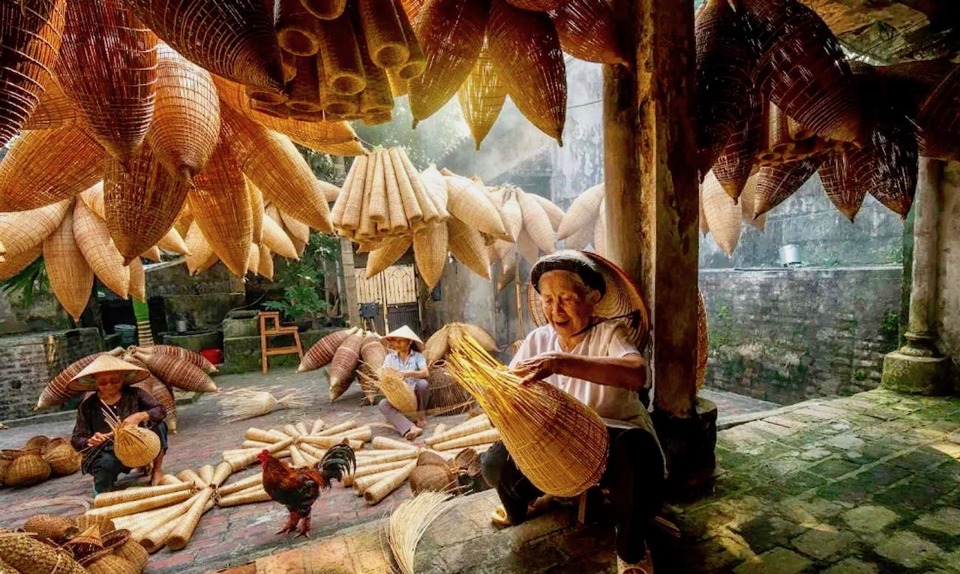Hanoi mayor pledges support for craft villages
Of Hanoi's US$50 billion annual GRDP, craft villages contribute one-fiftieth and provide tens of thousands of jobs.
Chairman of the Hanoi People's Committee Tran Sy Thanh promised today (July 5) that relevant agencies in Hanoi will work out specific policies to boost the development of craft villages in Hanoi, in line with the recently amended Capital Law.
| Rattan and bamboo products from Hanoi craftsmen. Photo: The Hanoi Times |
At the meeting with local craftsmen, the mayor said that the recently passed Capital Law provides for the protection and promotion of craft villages.
He said the city government is working on a policy to develop rural and handicraft villages.
"In formulating the policy, the city government expects input from the city's handicraft workshops, cooperatives, and households," he said.
According to Thanh, the development of handicraft production and traditional trading villages is a top priority for the Hanoi government.
"Of Hanoi's US$50 billion annual GRDP, craft villages contribute about VND24 trillion ($944.3 million), or about one-fiftieth, and provide tens of thousands of jobs," he said.
Most importantly, according to President Tran Sy Thanh, artisanal villages are a place to preserve and promote the unique cultural values of Hanoi and Vietnam in general, including values that have existed for thousands of years.
The development of craft villages has helped publicize Hanoi and Vietnamese culture to the world, confirming that Vietnam has a unique culture, Thanh said.
He admitted that the development of the city's artisan workshops has been hampered by the fact that the city government has occasionally failed to give the artisan villages the attention they deserved.
Although Hanoi is home to very high-quality OCOP (one commune, one product) handicrafts, their branding has not been taken care of, the mayor said.
According to Nguyen Manh Quyen, Deputy Chairman of the city's People's Committee, there are some 1,350 craft villages in Hanoi, of which 331 have been recognized as traditional craft villages.
He said that preserving handicrafts and combining them with cultural-agricultural-rural tourism is the key for Hanoi to improve people's incomes and living conditions.
"It is closely linked to the preservation of Vietnamese culture and is the backbone of new rural development," Quyen added.
Deputy Chairman Quyen praised handicrafts for their quality and design, saying that many of them are highly competitive in the world market because of their unique cultural characteristics.
He said the amended Capital Law supports the growth of handicraft production.
Opinions from local producers
At the meeting, Nguyen Van Tien Anh, Director of Phuong Dong Furniture Co., Ltd in Dong Anh District's Van Ha Commune, urged tour operators to send tourists to artisanal villages where they could buy souvenirs directly from the craftsmen.
| The meeting between the Hanoi People's Committee and local artisans. Photo: The Hanoi Times |
He said the marketing of handicrafts, with the strong support of the city government, would boost travel to the craft villages.
Nguyen Thi Luong, representative of Hien Luong Rattan and Bamboo Export Company in Phu Tuc Commune, Phu Xuyen District, appreciated the city's support in dealing with tax and customs issues and asked the city government to address some logistical problems and a lack of land for production.
Luong hoped the city would help artisan workshops participate in international fairs where they could market their handicrafts and promote trade.
Other business representatives called for policies to promote the use of technology as a means of saving costs and time in production while boosting output.
Nguyen Anh Duong, Director of the Hanoi Promotion Agency (HPA), said trade promotion is one of the city government's priorities. The agency has promoted handicraft products in the domestic and foreign markets and created opportunities for local producers to approach foreign retailers.
Duong said that at the HPA's trade promotion fair in Laos, many Hanoi handicrafts were displayed and introduced to local consumers.
"We will hold similar events for domestic and foreign consumers to get to know Hanoi handicrafts," Duong said.
The HPA will have a full subsidy package for handicraft workshops to set up booths at trade fairs.
According to the Hanoi Department of Planning and Architecture, the government is finalizing two projects for the capital's overall development through 2065 that aim to boost socio-economic growth in rural areas and preserve relics, craft villages, and natural and historical sites.
Under the two projects, there will be showrooms for artisan villages to display handicrafts and manufacturing demonstrations. In addition, handicraft workshops will be consolidated in industrial parks to free up land for agriculture.
The capital's government also aims to make handicraft production a spearhead that leads the tourism sector, and to integrate the planning of traditional villages into the city and urban area plan, thus preserving cultural features while achieving growth.













